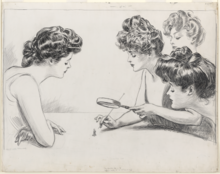...SHE WAS CREATED BY ARTIST CHARLES DANA GIBSON. IN THE PRIME OF HER YOUTH, SPARKLING, INCREDIBLY BEAUTIFUL, GRACEFUL AND ELEGANT, INTELLIGENT, VIVACIOUS, --- SINGLE, VERY LIKELY ANNOYINGLY UNATTAINABLE, --- COOLY INDIFFERENT TO PLAYBOY CHARMS...

YES, --- SHE WAS HAVING NO NONSENSE FROM ANYBODY, --- ESPECIALLY OBNOXIOUS, PREDATORY MALES. SHE WAS WAY TOO SMART FOR IT. ONE OF THE FEW THINGS A HANDSOME VICTORIAN MAN, NO DOUBT, COULD NOT TOLERATE WAS A BEAUTIFUL WOMAN WHO WOULD ADMIT HE WAS "NICE LOOKING," --- BUT, NO THANKS. IS HIS HEART BROKEN???... 💔😭NO, HE'S JUST FRUSTRATED AND INSULTED.👿
She was a member of upper middle class society, always perfectly dressed in the latest fashionable attire appropriate for the place and time of day. The Gibson Girl was also one of the new, more athletic-shaped women, who could be found cycling through Central Park, often exercised and was emancipated to the extent that she could enter the workplace. In addition to the Gibson Girl's refined beauty, in spirit, she was calm, independent, confident, and sought personal fulfillment. She could be depicted attending college and vying for a good mate, but she would never have participated in the suffrage movement.
Taking part in the suffrage movement was something more associated with the New Woman, another cultural image of women that emerged around the same time as the Gibson Girl. As a more popular version of the New Woman, the Gibson Girl both undermined and sanctioned women's desires for progressive sociopolitical change. The New Woman was the more disconcerting of the two images at the time as she was seen as an example of change and disruption within the old patterns of social order, asking for the right to equal educational and work opportunities as well as progressive reform, sexual freedom and suffrage. Whilst the Gibson Girl took on many characteristics of the New Woman, she did so without involving herself in politics and thus did not appear to contemporaries at the time to be usurping traditionally masculine roles as the New Woman was deemed to. She therefore managed to stay within the boundaries of feminine roles without too much transgression.
Gibson depicted her as an equal and sometimes teasing companion to men. She was also sexually dominant, for example, literally examining comical little men under a magnifying glass, or, in a breezy manner, crushing them under her feet. Next to the beauty of a Gibson Girl, men often appeared as simpletons or bumblers; and even men with handsome physiques or great wealth alone could not provide satisfaction to her. Gibson illustrated men so captivated by her looks that they would follow her anywhere, attempting to fulfill any desire, even if it was absurd. One memorable drawing shows dumbstruck men following a Gibson Girl's command to plant a young, leafless tree upside-down, roots in the air, simply because she wanted it that way. Most often, a Gibson Girl appeared single and uncommitted. However, a romance always relieved her boredom. Once married, she was shown deeply frustrated if romantic love had disappeared from her life, but satisfied if socializing with girlfriends or happy when doting on her infant child. In drawings such as these there was no hint at pushing the boundaries of women's roles; instead they often cemented the long-standing beliefs held by many from the old social orders, rarely depicting the Gibson Girl as taking part in any activity that could be seen as out of the ordinary for a woman.







No comments:
Post a Comment